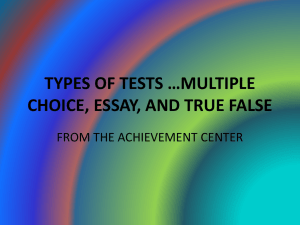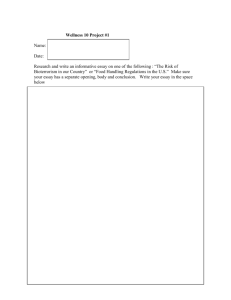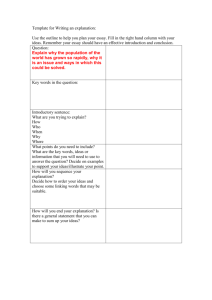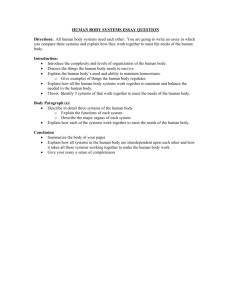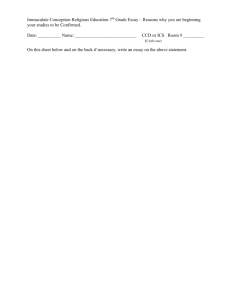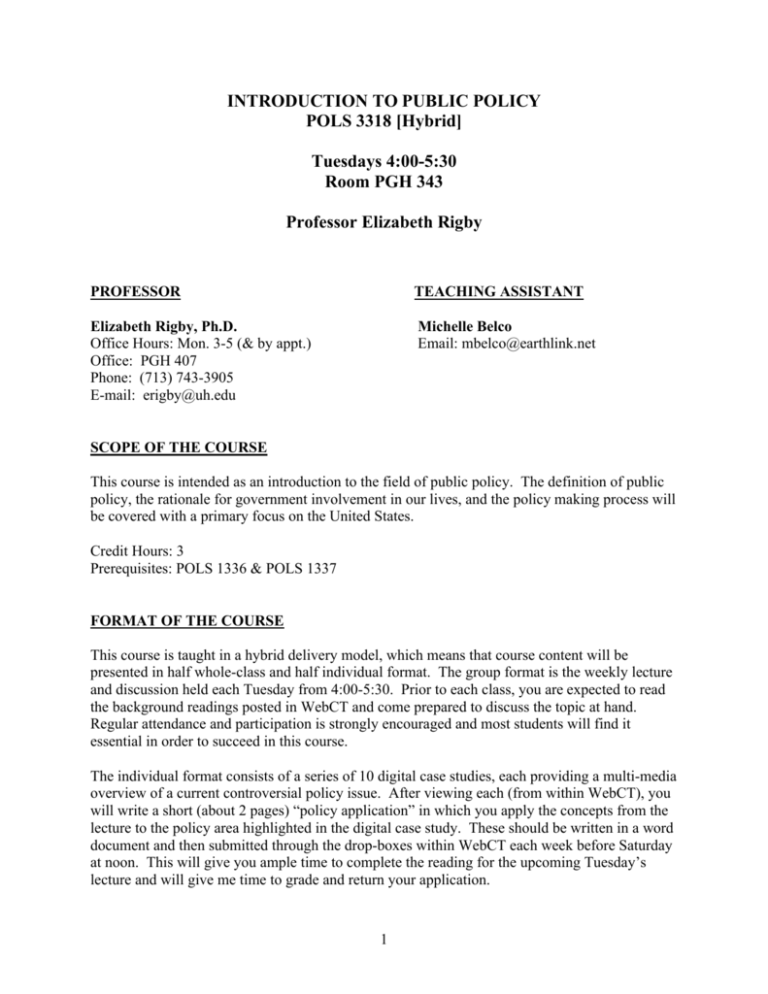
INTRODUCTION TO PUBLIC POLICY
POLS 3318 [Hybrid]
Tuesdays 4:00-5:30
Room PGH 343
Professor Elizabeth Rigby
PROFESSOR
TEACHING ASSISTANT
Elizabeth Rigby, Ph.D.
Office Hours: Mon. 3-5 (& by appt.)
Office: PGH 407
Phone: (713) 743-3905
E-mail: erigby@uh.edu
Michelle Belco
Email: mbelco@earthlink.net
SCOPE OF THE COURSE
This course is intended as an introduction to the field of public policy. The definition of public
policy, the rationale for government involvement in our lives, and the policy making process will
be covered with a primary focus on the United States.
Credit Hours: 3
Prerequisites: POLS 1336 & POLS 1337
FORMAT OF THE COURSE
This course is taught in a hybrid delivery model, which means that course content will be
presented in half whole-class and half individual format. The group format is the weekly lecture
and discussion held each Tuesday from 4:00-5:30. Prior to each class, you are expected to read
the background readings posted in WebCT and come prepared to discuss the topic at hand.
Regular attendance and participation is strongly encouraged and most students will find it
essential in order to succeed in this course.
The individual format consists of a series of 10 digital case studies, each providing a multi-media
overview of a current controversial policy issue. After viewing each (from within WebCT), you
will write a short (about 2 pages) “policy application” in which you apply the concepts from the
lecture to the policy area highlighted in the digital case study. These should be written in a word
document and then submitted through the drop-boxes within WebCT each week before Saturday
at noon. This will give you ample time to complete the reading for the upcoming Tuesday’s
lecture and will give me time to grade and return your application.
1
In addition, there will be three exams covering key terminology and concepts. The first exam
(9/30) will cover content from Units I and II; the second exam (11/11) will cover content from
Units III and IV; and the final exam (12/9) will be cumulative final covering content from Units I
through V. All three exams will be held in the CLASS testing center and will be closed-book,
closed-notes exams, although students will be allowed to bring a copy of Orwell’s Animal Farm
to the final exam.
GRADING SCHEME
Your final grade in this course will be computed as follows:
Policy Applications (best 8 of 10)
Exam I
Exam II
Final Exam
40%
20%
20%
20%
Note: Course attendance and participation will be taken into consideration in determining
final grades for students on the borderline between two grades (i.e. between B+ and A-).
COURSE SCHEDULE
UNIT 1: INTRODUCTION TO POLICY AND POLICY MAKING
Lesson 1-A (8/26): Government in our Lives
Reading: “Public Policy,” pg. 1-4 from: Dye,
Thomas R. 2007. Understanding Public
Policy, 12th Edition. Upper Saddle River, NJ:
Pearson Prentice Hall
Key Term: public policy
Size of Government Policy Application: Watch digital case study, write a short essay (2 pages)
answering the following questions:
1. What are the advantages of a bigger government?
2. What are the disadvantages?
3. In your opinion, what types of problems, issues, or services should government be
responsible for? And what problems, issues, or services should be left to individuals to
deal with/solve?
4. Do you think government should be bigger or smaller than it is now?
2
Lesson 1-B (9/2): Decision-Making: The Case of Landfill Politics
Reading 1: “Decision Making,” p. 62-67 from:
Shafritz, Jay M. and Christopher P. Borick. 2008.
Introducing Public Policy. New York: Pearson.
Reading 2: “The Science of Muddling Through"
pg. 79-83 from: Lindblom, Charles E. 1959.
Public Administration Review, 19(2), 79-88.
Key Terms: Rationality, bounded rationality,
rational decision making, incrementalism,
uncertainty, mixed scanning
Landfill Policy Application: Watch digital case study and powerpoint reviewing three potential
locations for the landfill, write a short essay (about 2 pages) answering the following questions:
1. Which location would you choose for the landfill? Why?
2. How did you make this decision?
3. What were your primary considerations in making this decision?
4. To what degree did you employ a rational decision making process?
UNIT 2: POLICY PROBLEMS
Lesson 2-A (9/9): Causal Stories: Case of Illegal Immigration
Reading 1: “The Social Construction of Problems,” p. 125133 from: Birkland, Thomas A. (2005). An Introduction to
the Policy Process. New York: M.E. Sharpe.
Reading 2: “Social Constructions of Target Populations:
Degenerative Policy Designs,” p. 102-111 from: Schneider,
Anne Larason and Helen Ingram. 1997. Policy Design for
Democracy. Lawrence, KS: University of Kansas Press.
Key Terms: policy problems, social construction, causal
stories, conditions/indicators, symbols, outliers, target
populations, degenerative policy designs, instrumental
messages, symbolic messages
Policy Application: Watch digital case study and skim CQ Researcher on immigration issue,
write a short essay (about 2 pages) answering the following questions:
1. What is the causal story told by supporters of efforts to crack down on illegal
immigration? What is the causal story told by opponents?
2. What causal story would you tell (and believe) about this pressing policy issue?
3
Lesson 2-B (9/16): Collective Action Problems: Case of Recycling
Reading: “Collective Action,” p. 61-67 & 79-83 &
175 from: Bickers, Kenneth N. and John T.
Williams. (2001). Public Policy Analysis: A
Political Economy Approach. Boston, MA:
Houghton Mifflin.
Key Terms: collective action problems, rationality,
self-interest, preferences, selective incentives, free
riders, public goods, externalities, free riders,
eminent domain, coerciveness, incentives/carrots,
mandates/sticks, sermons/appeals.
Recycling Policy Application: Watch digital case study and skim CQ Report on recycling, write
a short essay (about 2 pages) answering the following questions:
1. For the case of recycling, what is the collective action problem?
2. How could the problem be best solved?
3. What mix of carrots, sticks, and sermons would you recommend?
Lesson 2-C (9/23): Market Failures: Case of Home Foreclosures
Reading: “Market Failure,” p. 118-131 from:
Bickers, Kenneth N. and John T. Williams.
(2001). Public Policy Analysis: A Political
Economy Approach. Boston, MA: Houghton
Mifflin.
Key Terms: markets, market failure,
underproduction of public good, congestion,
negative externalities, monopoly, information
failure, types of goods: search goods, experience
goods, post-experience goods, adverse selection
Home Foreclosure Policy Application: Watch digital case study, write a short essay (about 2
pages) answering the following questions:
1. What type of goods are involved in this case (i.e. rivalrous, excludable, congestable,
search, experience, post-experience, public, private)?
2. Describe 2-3 examples of different types of market failure involved in this case?
3. Do you think government should be more or less involved in regulating lenders?
EXAM I (9/30): During class time in testing center
4
UNIT 3: POLICY SOLUTIONS
Lesson 3-A (10/7): Policy Tools: Case of Energy Independence
Reading 1: “Policy Types,” p. 141-148 from:
Birkland, Thomas A. (2005). An Introduction to
the Policy Process. New York: M.E. Sharpe.
Reading 2: “Policy Tools,” p. 19-37 from:
Salamon, Lester M. (Ed), The Tools of
Government: A Guide to the New Governance.
Oxford: Oxford University Press.
Key Terms: policy tool, policy benefits and costs,
distributive, redistributive, regulatory policies,
direct government, social regulation, economic
regulation, contracts, grants, loans, loan
guarantees, insurance, tax expenditure, fees,
charges, liability law, government corporations,
vouchers, coercion, behavioral theory/policy
targets
Energy Policy Application: Watch digital case study and read the Roosevelt Institute’s “25 Ideas
Report” write a short essay (about 2 pages) answering the following questions:
1. What five ideas do you think are the most promising?
2. For each, describe what type of policy it entails (distributive, redistributive, regulatory).
3. For each, identify the specific policy tool (i.e. tax expenditure, direct government).
4. What tools do you think will be most effective in solving this problem? Why?
Week 3-B (10/14): Goal conflict: The Case of Homeland Security
Reading: “Policy Goals,” p. 159-168 from:
Birkland, Thomas A. (2005). An Introduction
to the Policy Process. New York: M.E.
Sharpe.
Key Terms: policy goals, goal conflict,
security, efficiency, equity, liberty
Homeland Security Policy Application: Watch digital case study, review CQ report on Privacy in
Peril, and write a short essay (about 2 pages) answering the following questions:
1. Describe two or three distinct types of goal conflict in the area of homeland security?
2. For each, give your opinion regarding which goal should be prioritized. And why.
5
Lesson 3-C (10/21): Government Failure: Case of Disaster Management
Reading 1: “Government Failure” from: Riley, Geoff,
www.tutor2u.net
Reading 2: “Why Government is the Problem.” Friedman,
Milton. Palo Alto: The Hoover Institution.
Key Terms: government failure, political self-interest, short
time horizons, market distortion, agency capture,
disincentive effects, incentives for evasion, imperfect
information, moral hazard
Government Failure Policy Application: Watch digital case study and write a short essay (about
2 pages) answering the following questions:
1. Identify at least three different forms of government failure in the response to Hurricane
Katrina, describe each one.
2. Should government be responsible for assistance and clean-up after natural disasters?
Why or why not?
3. What could government do differently were this to happen again?
UNIT 4: POLICY CONTEXT
Lesson 4-A (10/28): Fragmented by design: Case of Medical Marijuana
Reading: “Structure of Policymaking in American
Government,” p. 21-38 from: Peters, B. Guy (2007).
American Public Policy: Promise and Performance, 7th
Edition. Washington, DC: CQ Press.
Key Terms: fragmentation, centralization vs.
decentralization, gridlock, separation of powers
(executive, legislative, judicial branches), divided
government, subgovernments, federalism (inc. layer cake
and marble cake), venue shopping, public interests,
private interests, corporatism
Medical Marijuana Policy Application: Watch digital case study and review CQ report on
Marijuana Laws. Write a short essay (about 2 pages) answering the following questions:
1. How are the different forms of fragmentation illustrated in this case?
2. What are the advantages and disadvantages of so much fragmentation in this area?
6
Lesson 4-B (11/4): Iron Triangles and Issue Networks: Case of Food Politics
Reading 1: “Interest Groups and Public Policy,” p. 54-58
from: Kraft, Michael E. and Scott R. Furlong (2007).
Public Policy: Politics, Analysis, and Alternatives, 2nd
Edition. Washington, DC: CQ Press.
Reading 2: “Advocacy Coalitions/Punctuated Equlibrium,”
p. 226-229 from: Birkland, Thomas A. (2005). An
Introduction to the Policy Process. New York:. Sharpe.
Key Terms: interest groups, lobbying, issue networks, iron
triangles, advocacy coalitions, punctuated equilibrium,
policy monopoly, policy image
Food Politics Policy Application: Watch digital case study and read the two Pollan articles on the
2007 Farm Bill. Write a short essay (about 2 pages) answering the following questions:
1. How does Pollan describe the food-policy issue networks in the first article?
2. What about in the second article? What changed? Why?
EXAM II (11/11): During class time in testing center
UNIT 5: IMPROVING POLICYMAKING INSTITUTIONS
Lesson 5-A (11/18). Centralizing Policy Authority: Case of the New Deal
Readings: “Perfecting the Presidency,”
from Sabato, Larry J. A More Perfect
Constitution: 23 Proposals to Revitalize
our Constitution and Make America a
Fairer Country (p. 76-104).
Key Terms: Constitution; constitutional
convention, line item veto
No Policy Application due –
Start reading Animal Farm
7
NO CLASS (11/25): Thanksgiving week
Lesson 5-B (12/2). The Challenge of Self-Government: Case of Animal Farm
Reading:
Orwell, George.
Animal Farm.
[any year/edition/publisher]
FINAL EXAM (12/9): During class time in testing center
8

